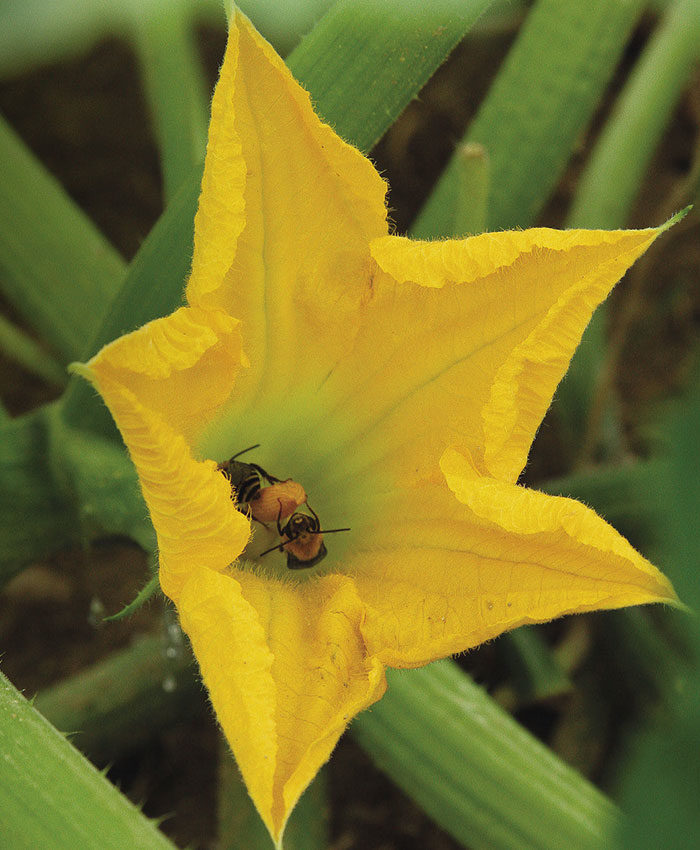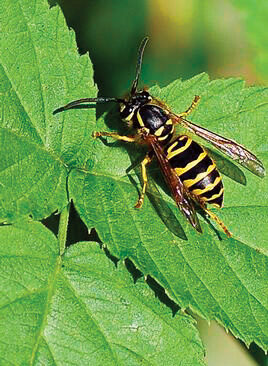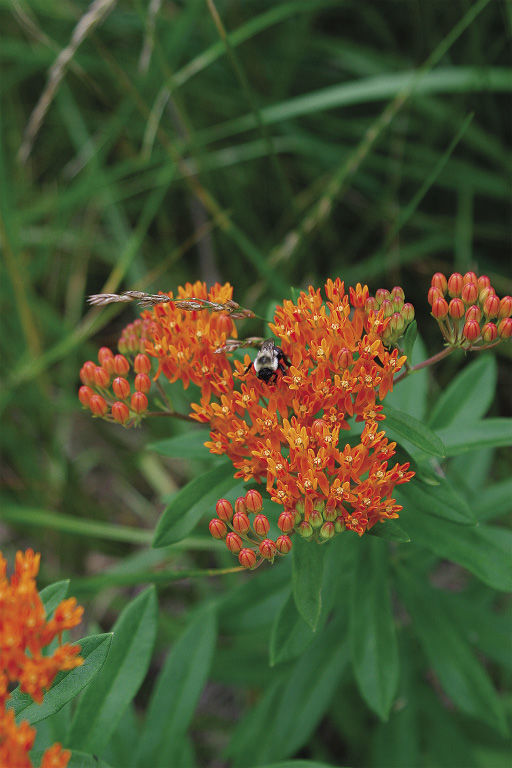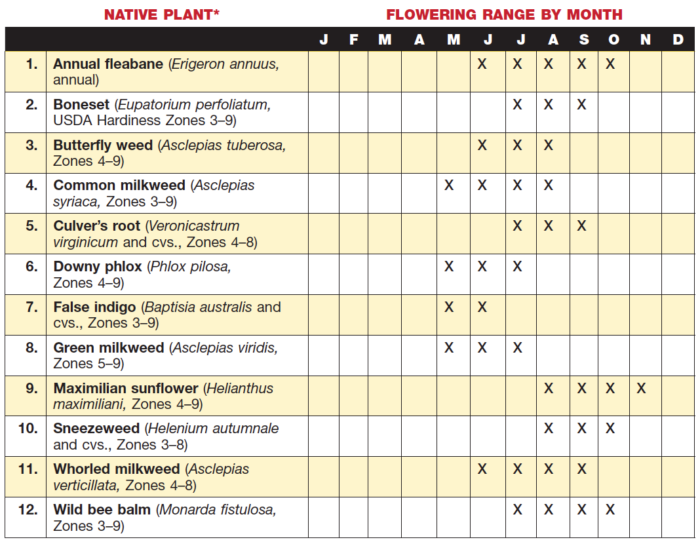Grow More Flowers to Harvest More Food
Planting native flowers within a vegetable garden attracts bees and results in healthier, more prolific crops

We have all watched pollinators go about their business with flowers. But just how—if at all—do they work in conjunction with the vegetable garden? And will the addition of flowers to the vegetable garden increase crop yield? The answer is “Yes,” especially if the flowers are native. More native flowers leads to more pollinating bees and a healthier, more abundant food harvest.
A few bees do the bulk of the work

Did you know . . .
. . . that wasps (pictured) are not bees or pollinators? These pests are often confused with bees, thus giving bees an undeserved bad rap.
Incorporate flowers into vegetable-bed design
Planting flowers that attract bees will help fill gaps when vegetables are not blooming and throughout the fruiting season, providing bees with food necessary for survival and drawing more pollinators to the vegetable garden. And attracting more pollinators to the vegetable garden means that more edible plants will be pollinated, resulting in healthier yields. Scientists study how well edibles have been pollinated, in fact, by examining the number of fully formed seeds inside the fruit: If the plant parts are symmetrical, the edible was pollinated successfully; if the seeds are askew, it was not—more than likely because there was a dearth of bee pollinators.
To attract bees, begin by creating a bloom chart. Select native flowers that attract bees. List the months of the year across the top of the chart. Highlight the months each plant is expected to bloom as this will help ensure that you have full floral coverage for bees.
If you are just starting a garden that will attract bees, consider planting at least a few mature perennials, rather than planting all by seed. Mature plants will attract bees right away, while it can take one to three years for seeds to produce flowers.
Select plants with showy flowers. The showier the flower, the more likely that bees will be drawn to it. Similarly, the larger the grouping of flowers, the more appealing it will be to bees. When bees find a plant that they like, they will hone in on it and stay in the area for many hours. Large clumps or groupings of flowers make the bees’ task easier as they will be less likely to fly away from such an abundant source of nectar and pollen.
 |
 |
 |
*Note: This list is just a sample of bee pollinator–friendly plants. For plants appropriate for your area, visit pollinator.org or download the free BeeSmart Pollinator Gardener app.
 |
 |
Consider planting a strip of native flowers in the middle of a vegetable garden and around the border. This will keep pollinators close to your vegetable garden, increasing pollination activity. Planting only a few flowers near a vegetable garden means that bees will fly away from vegetables to look for other food sources. This, in turn, results in a shortage of vegetable pollinators.
Provide protection for pollinators
Pollinators need water and shelter to survive. Not all bees live in hives; they can be ground nesters or hole nesters, or they can live in bee houses. Squash bees, for example, are ground nesters, so they lay the eggs of the next generation in nests within the soil. For this reason, reconsider tilling the soil. Leaving nests undisturbed will help ensure that squash-bee eggs develop into adults and emerge the following year to pollinate your crops. In addition, where possible, leave a patch of bare sunny ground in your vegetable garden to invite those same ground nesters to make a home. Avoid overmulching or laying down weed cloth as both can be detrimental to ground-nesting bee populations. While our natural tendency is to keep a tidy garden, leaving a little leaf litter, some hollow stems of plants past, or a few native grasses will provide bees with shelter.
Fresh, chemical-free water is also necessary for bees. Keep in mind that pesticides marketed to kill certain insects often kill all insects, including beneficial bees. If you must use pesticides, it is best to do so after the bees’ busiest work hours of 9 a.m. to 3 p.m. (or earlier in the morning for squash bees).
Bee pollinators are essential to a successful vegetable garden. For that reason, it is important to plant a variety of pollinator-attracting flowers—especially natives—in your vegetable garden to successfully pollinate all of your crops. Plus, this provides the added benefit of increasing the amount of native flowers in your garden throughout the growing season.
A succession of blooms is critical for attracting bees to edibles
Adding native plants that bloom from the beginning to the end of the growing season leads to better pollination of edibles.
Remember the borders
Planting a strip of native flowers in the middle of each vegetable bed and around the border will keep bees close, increasing pollination activity.
Entice bees by planting showy flowers
Bees are more likely to be attracted to gardens that are filled with showy flowers and to remain to pollinate vegetables if flowers are abundant.
Coordinate flowering time
Ensure that bees always have a source of pollen and nectar by planting natives and vegetables that bloom simultaneously.
Mary Byrne Rager is the plant ecologist for the Pollinator Partnership, a San Francisco–based organization dedicated exclusively to the protection and promotion of pollinators and their ecosystems.
Photos: Lynn Felici-Gallant; Steve Aitken; Nancy J. Ondra; Bill Johnson; courtesy of Jon Yuschock/bugwood.org. Illustration: Carol Collins
Fine Gardening Recommended Products

Ashman Garden Cultivator (1Pack)
Fine Gardening receives a commission for items purchased through links on this site, including Amazon Associates and other affiliate advertising programs.

ARS Telescoping Long Reach Pruner
Fine Gardening receives a commission for items purchased through links on this site, including Amazon Associates and other affiliate advertising programs.

Corona® Multi-Purpose Metal Mini Garden Shovel
Fine Gardening receives a commission for items purchased through links on this site, including Amazon Associates and other affiliate advertising programs.








Comments
Log in or create an account to post a comment.
Sign up Log in